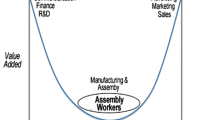Abstract
India is a major producer and exporter of hand-knotted carpets to the world since the beginning of the British rule over India. Majority of the hand-knotted carpets exported from India are produced in the Bhadohi-Mirzapur region, popularly called as the carpet belt of India. Given deplorable working conditions and very high prevalence of child labour in the cluster, in the mid-1990, four social labels were implemented to improve the labour standards, in addition to slew of labour laws implemented by the state of India. The objective of this study is to explore the prevailing labour standards and effectiveness of social labels in improving labour standards in the hand-knotted carpet manufacturing cluster. This study found that even after the implementation of social labels and slew of labour laws, there had been barely any improvement in the working conditions of carpet workers. The workers continued to be adversely incorporated in the carpet commodity chain. However, realising that there is very little scope of social upgrading in this occupation, many carpet workers have shifted to other occupations. But this study found very few child workers in carpet manufactories in the cluster.

Similar content being viewed by others
References
Bair, J., & Gereffi, G. (2001). Local clusters in global chains: the causes and consequences of export dynamism in Torreon’s Blue Jeans industry. World Development, 29(11), 1885–1903.
Barrientos, S., & Kritzinger, A. (2004). Squaring the circle: global production and the informalization of work in South African fruit Exports. Journal of International Development, 16(1), 81–92.
Barrientos, S., & Smith, S. (2007). Do workers benefit from ethical trade? Assessing codes of labour practices in global production systems. Third World Quarterly, 28(4), 713–729.
Barrientos, S., et al. (2000). Ethical trade and South African deciduous fruit exporters—addressing gender Sensitivity. European Journal of Development Research, 12(1), 140–158.
Barrientos, S., et al. (2003). A gendered value chain approach to codes of conduct in African horticulture. World Development, 31(9), 1511–1526.
Barrientos, S., et al. (2011). Economic and social upgrading in global production networks: a new paradigm for a changing world. International Labour Review, 150(3&4), 319–340.
Barrientos, S., Mathur, K., & Sood, A. (2010). Decent Work in Global Production Networks: Challenges for Vulnerable Workers in the Indian Garment Sector’. In A. Posthuma & D. Nathan (Eds.), Labour in Global Production Networks in India (pp. 127–145). New Delhi: Oxford University Press.
Blowfield, M. (1999). Ethical trade: a review of development and issues. Third World Quarterly, 20(4), 753–770.
Blowfield, M., & Frynas, J. F. (2005). Setting new agendas: critical perspectives on corporate social responsibility in the developing world. International Affairs, 81(3), 499–513.
Cavanagh, J. (1997). The Global Resistance to Sweatshops, in Andrew Ross (ed.) No Sweat: Fashion, Free Trade and the Rights of Garment Workers, 39–50, Verso, London.
Chakrabarty, S., & Grote, U. (2009). Child labour in carpet weaving: impact of social labelling in India and Nepal. World Development, 37(10), 1683–1693.
Chan, A. (1998). Labour standards and human rights: the case of Chinese workers under market socialism. Human Rights Quarterly, 20(4), 886–904.
Chowdhary, G., & Beeman, M. (2001). Challenging child labour: transnational activism and India’s carpet industry. Annals of the American Academy of Political and Social Sciences, 575(1), 158–175.
De Neve, G. (2009). Power, Inequality and Corporate Social Responsibility: The Politics of Ethical Compliance in the South Indian Garment Industry, Economic and Political Weekly XLV(2): 63–71.
De Neve, G. (2014). Fordism, flexible specialisation and CSR: how Indian garment workers critique neoliberal labour regimes. Ethnography, 15(2), 184–207.
Dolan, C., & Humphrey, J. (2000). Governance and trade in fresh vegetables: the impact of UK supermarkets on the African horticulture industry. Journal of Development Studies, 37(2), 147–176.
Dolan, C. S., & Opondo, M. (2005). Seeking common ground-multi-stakeholder processes in Kenya’s cut flower industry. Journal of Corporate Citizenship, 18(1), 87–98.
Frank, D. (2003). Where are the workers in consumer-worker alliances? class dynamics and the history of consumer-labour campaigns. Politics and Society, 3(3), 363–379.
Frenkel, S. J. (2001). Globalisation, athletic footwear commodity chains and employment relations in China. Organisation Studies, 22(4), 531–562.
Gereffi, G. (1994a). The Organisation of the Buyer-Driven Global Commodity Chains: How US Retailers Shape Overseas Production Networks. In G. Gereffi & M. Korzeniewicz (Eds.), Commodity Chains and Global Capitalism (pp. 95–122). Westport, CT: Praeger.
Gereffi, G. (1994b). Introduction: Global Commodity Chains. In G. Gereffi & M. Korzeniewicz (Eds.), Commodity Chains and Global Capitalism (pp. 1–14). Westport: Praeger.
Gereffi, G. (1995). Global Production Systems and Third World Development”. In B. Stallings (Ed.), Global Change, Regional Response: The International Context of Development (pp. 100–142). Cambridge: Cambridge University Press.
Gereffi, G. (1999). International trade and industrial upgrading in the apparel commodity chain. Journal of International Economics, 48(1), 37–70.
Gereffi, G. (2001). Beyond the producer-driven/buyer-driven dichotomy. The evolution of global value chains in the Internet era. IDS Bulletin, 32(3), 30–40.
Gereffi, G., et al. (2001). Globalisation, value chains and development. IDS Bulletin, 32(3), 1–9.
Gereffi, G., et al. (2005). The governance of global value chains. Review of International Political Economy, 12(1), 78–104.
Goswami, K. K. (2009). Developments in Handmade Carpets: Introduction. In K. K. Goswami (Ed.), Advances in Carpet Manufacture (pp. 138–181). Cambridge: Woodhead Publishing.
Hale, A., & Opondo, M. (2005). Humanizing the cut flower chain: confronting the realities of flower production for workers in Kenya. Antipode, 37(2), 301–323.
Hilowitz, J. (1997). Social labelling to combat child labour: some considerations. International Labour Review, 136(2), 215–232.
Humphrey, J., & Schmitz, H. (2001). Governance in global value chains. IDS Bulletin, 32(3), 19–30.
Kabeer, N. (2004). Globalisation, labour standards and women’s rights: dilemmas of collective (in) action in an interdependent world. Feminist Economics, 10(1), 3–35.
Kaplinsky, R. (2000). Globalisation and unequalisation: what can be learned from value chain analysis? Journal of Development Studies, 37(2), 117–146.
Lerche, J. (2007). A global alliance against forced labour? unfree labour, neo-liberal globalization and the international labour organization. Journal of Agrarian Change, 7(4), 425–452.
Luce, S. (2005). The Case for International Labour Standards: A ‘Northern’ Perspective’, Institute of Development Studies, Working Paper 250, Brighton, Sussex, available on http://www.ids.ac.uk/files/Wp250.pdf (accessed 8 January 2015).
Lund-Thomsen, P., & Nadvi, K. (2010a). Cluster, chains and compliance: corporate social responsibility and governance in football manufacturing in South Asia. Journal of Business Ethics, 93(2), 201–222.
Lund-Thomsen, P., & Nadvi, K. (2010b). Global, value chains, local collective action and corporate social responsibility: a review of empirical evidence. Bus Strat Environ, 19(1), 1–13.
Lund-Thomsen, P., et al. (2012). Labour in global value chains: work conditions in football manufacturing in China, India and Pakistan. Development and Change, 43(6), 1211–1237.
Maertens, M., & Swinnen, J. F. M. (2009). Trade, standards, and poverty: evidence from Senegal. World Development, 37(1), 161–178.
Mezzadri, A. (2014). Indian garment clusters and CSR norms: incompatible agendas at the bottom of the garment commodity chain. Oxford Development Studies, 42(2), 235–258.
Nadvi, K. (2004). The Effect of Global Standards on Local Producers: A Pakistani Case Study. In H. Schmitz (Ed.), Local Enterprises in the Global Economy: Issues of Governance and Upgrading (pp. 297–325). Cheltenham: Elgar.
Nadvi, K., et al. (2004). Challenges to Vietnamese firms in the world garment and textile value chain, and the implications for alleviating poverty. Journal of the Asia Pacific Economy, 9(2), 249–267.
Nielsen, M. E. (2005). The politics of corporate responsibility and child labour in the Bangladeshi garment industry. International Affairs, 81(3), 559–580.
Papola, T. S., & Pais, J. (2007). Debate on labour market reforms in India: a case of misplaced focus. Indian Journal of Labour Economics, 50(2), 183–200.
Polaski S. (2004). Cambodia Blazes a New Path to Economic Growth and Job Creation’, Carnegie Paper 51, Carnegie Endowment for International Peace, Washington DC. http://carnegieendowment.org/files/cp51polaskifinal2.pdf (accessed 2 December 2014).
Rafi Khan, F. (2004). Hard Times Recalled-Child Labour in Pakistan’s Soccer Ball Industry. In F. Bird (Ed.), International Business and the Dilemmas of Development (pp. 132–155). Basingstoke: Palgrave MacMillan.
Ravi, A. (2001). Combating child labour with labels: case of Rugmark. Economic and Political Weekly, 36(13), 1141–1147.
Reardon, T., et al. (1999). Global change in agrifood grades and standards: agribusiness strategies responses in developing countries. International Food and Agribusiness Management Review, 2(3&4), 421–435.
Riisgaard, L. (2009). Global value chains, labour organisation and private social standards: lessons from East African cut flower industries. World Development, 37(2), 326–340.
Ruwanpura, K. (2013). Scripted performances? local readings of ‘Global’ health and safety standards (the apparel sector in Sri Lanka). Global Labour Journal, 4(2), 88–108.
Seigman, K. A. (2008). Soccer ball production for Nike in Pakistan. Economic and Political Weekly XLIII, 22, 57–64.
Sen, A. K. (2001). Work and Rights. In M. F. Loutfi (Ed.), Women, Gender and Work: What is Equality and How Do We Get There? (pp. 33–44). Geneva: International Labour Office.
Sharma, A. N. (2002). Impact of social labelling on child labour in carpet industry. Economic and Political Weekly, 37(52), 5196–5204.
Sturgeon, T. (2001). How do we define value chains and production networks? IDS Bulletin, 32(3), 9–18.
Tallontire, A., et al. (2005). Reaching the marginalised? gendered value chains and ethical trade in African horticulture. Development in Practice, 15(3&4), 559–571.
Taylor, M. (2011). Race you to the bottom… back again? the uneven development of labour codes of conduct. New Political Economy, 16(4), 445–462.
Yu, X. (2008). Impacts of corporate code of conduct on labour standards: a case study of Reebok’s athletic footwear supplier factory in China. Journal of Business Ethics, 81(3), 513–529.
Author information
Authors and Affiliations
Corresponding authors
Rights and permissions
About this article
Cite this article
Giri, A.K., Singh, S.P. Labour standards in global value chains in India: the case of handknotted carpet manufacturing cluster. Asian J Bus Ethics 5, 37–52 (2016). https://doi.org/10.1007/s13520-016-0052-8
Published:
Issue Date:
DOI: https://doi.org/10.1007/s13520-016-0052-8




